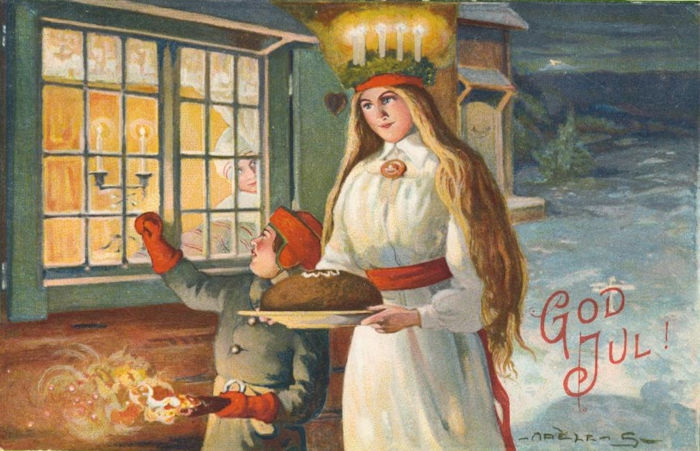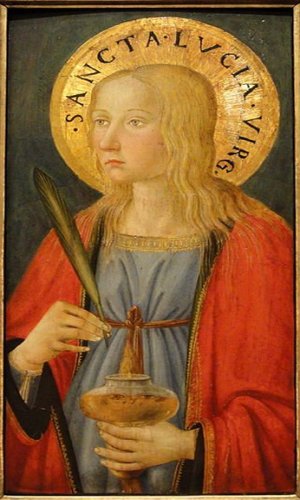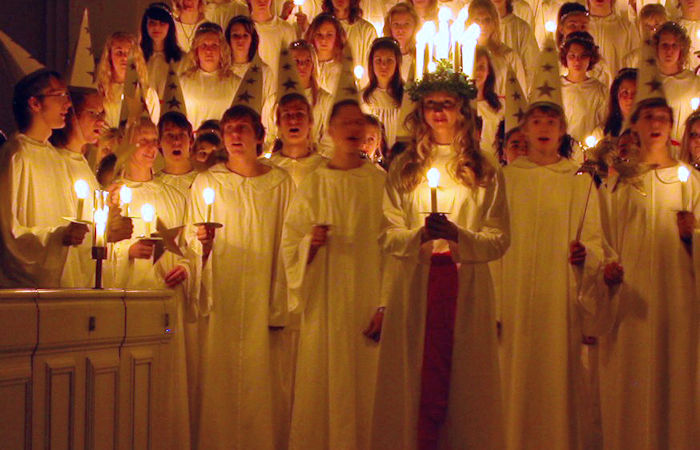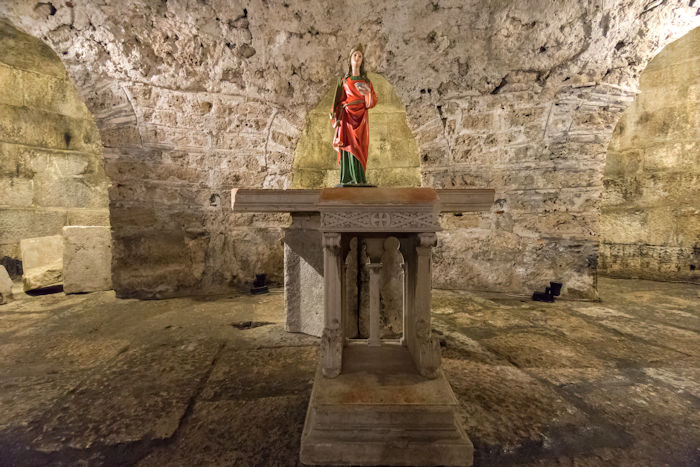Why We Celebrate Saint Lucy’s Day – The Bringer Of Light And Patron Of The Blind
Ellen Lloyd - AncientPages.com - On December 13, the Feast of Saint Lucy is celebrated in some countries. This memorable Christmas holiday is of great importance, mainly in Scandinavia and Italy.
Christmas season card with Lucia in the snow. Adèle Söderberg (1880-1915) Credit: Public Domain
It's called St. Lucy Day (also known as St. Lucia Day). The celebration is in honor of Saint Lucy. She was a martyr who became a patron of the blind and those with eye disorders who died during the Diocletianic Persecution.
The Woman Was Killed Because She Wanted To Help Poor People
Known as St. Lucia of Syracuse, the woman was honored in the Middle Ages and remained a well-known saint in early modern England. According to legend, she brought food and aid to Christians hiding in the catacombs using a candle-lit wreath to light her way and leave her hands free to carry as much food as possible.
In addition, she helped her fellow Catholics hiding in the dark underground catacombs who were at risk of persecution.
Saint Lucy was also well known for her beautiful eyes. It was said that her eyes radiated her love for Christ.
Lucy was born to rich and noble parents in the year 283. Her father was of Roman origin but died when she was five, leaving Lucy and her mother without a protective guardian. Her mother's name, Eutychia, indicates she was of Greek origin. Lucy was deeply religious and wanted to devote herself to God. She didn't want to get married. Instead, she wanted to do something for poor people.
However, her mother feared Lucy's future arranged marriage to a young man from a wealthy pagan family. Lucy's mother suffered from a bleeding disorder, and her condition made Lucy deeply worried.
Saint Lucy by Cosimo Rosselli, Florence, c. 1470. Credit: Public Domain
One night, while dreaming, Lucy saw Saint Agatha martyred fifty-two years during the Decian persecution. The saint told Lucy that because of her faith in God, her mother would be cured, and Lucy would be Syracuse's glory, as she was of Catania.
With her mother cured, Lucy took the opportunity to persuade her mother to allow her to distribute a significant part of her riches among people experiencing poverty.
Lucy Becomes A Martyr
The Pagan man who proposed to Lucy was furious when he heard the news. He destroyed Lucy's life, denouncing her as a Christian to the Governor of Syracuse, Sicily.
That was a time when many Christians were persecuted for their faith.
Saint Lucy by Cosimo Rosselli, Florence, c. 1470. Credit: Public Domain
When the Governor of Syracuse learned the jewelry had been given away to people experiencing poverty, he became furious. The governor sentenced her to forced prostitution, but when guards went to fetch her, they could not move her even when they hitched her to a team of oxen.
Saint Lucy celebration in a Swedish church. Credit: Claudia Gründer - CC BY-SA 3.0
The governor ordered her killed instead. After torture that included having her eyes torn out, she was surrounded by bundles of wood set afire; they went out. She prophesied against her persecutors and was executed by being stabbed to death with a dagger. Her name is listed in the "Nobis quoque peccatoribus" prayer in the Canon of the Mass.
Legend says her eyesight was restored before her death. That was why she became the patron saint for people who are blind and suffer from eye disorders.
The Feast Of St. Lucy
St. Lucy (Lucia) feast day brings various celebrations in various countries. Her feast is also tied in with the celebration of light and winter, as her name means light, and her feast day originally coincided with the winter solstice, which marked the shortest day of the year.
Crypt of Saint Lucy, under the Cathedral of Saint Domnius in the Diocletian's Palace in the ancient city of Split in Croatia. Credit: Adobe Stock - Barbara
Croatians Place A Plant On A Christmas Tree
In Croatia, it is customary to plant Christmas wheat on the feast of St. Lucy. Plant the seeds into a small soil dish, and place the plate in a moderately warm room, keeping it watered. The fresh wheat shoots should be about 8 inches soft green by Christmas Eve.
The wheat then can be placed next to the manger or crib scene as a gift to Jesus. It can also be a table decoration with a candle in the center.
It also reminds us of the Eucharist feeding our souls and as the staff of life that nourishes all humanity.
Important Feast In Italy
Saint Lucy is celebrated all over Italy. Sicilians still commemorate Saint Lucy's intervention during a severe famine in 1582. Miraculously, ships filled with grain appeared in the harbor on December 13.
It is custom to eat plenty of "Lussekatter" (Lusse buns) on the feast of Saint Lucy. Credit: Per Ola Wiberg - CC BY 2.0
To this day, Sicilians refuse to eat anything made of wheat flour, which means forgoing pasta and bread. Instead, they eat the most popular dish, Cuccia, made with boiled whole wheat berries, ricotta, and sugar. The people were so hungry that they didn't take the time to grind the grain into flour but cooked the grains immediately.
Luciadagen In Sweden
Alongside Midsummer, the Lucia celebrations represent one of the highest cultural traditions in Sweden. It is a special feast day in Sweden called Luciadagen.
It is custom to dress a girl in a white dress with a red sash around her waist and a crown of candles on her head. There was a time when real candles were used, but this was much too dangerous. Instead, Lucia's girl wears a crown with white lighted electronic candles.
The crown is made of evergreen Lingonberry branches that symbolize new life in winter. It is custom that there is a Saint Lucia celebration in every school, and some towns and villages also choose a girl to play St. Lucia in a procession where carols are sung.
A national Lucia is also chosen. Lucias also visits hospitals and old people's homes, singing about St Lucia and handing out 'Pepparkakor' ginger snap biscuits.
Small children sometimes like dressing up as Lucia (with the help of their parents!). Also, boys might dress up as 'Stjärngossar' (star boys), and girls might be 'tärnor' (like Lucia but without the candles).
Eating so-called "Lussekatter," buns flavored with saffron and dotted with raisins on St. Lucy's Day in Sweden, is trendy.
The feast is charming to watch in the northern part of the country, where you can see the Lucia procession walk outdoors in the dark from house to house in the snow, holding candles.
Saint Lucy's Day is also celebrated in Denmark, Finland, Norway, Bosnia, Malta, and certain places in the United States.
Written by Ellen Lloyd – AncientPages.com
Updated on December 10, 2023
First version of this article was originally published on December 13, 2015
Copyright © AncientPages.com All rights reserved. This material may not be published, broadcast, rewritten or redistributed in whole or part without the express written permission of AncientPages.com
Expand for referencesMore From Ancient Pages
-
 Powerful Winds In Ancient Beliefs
Featured Stories | Feb 5, 2024
Powerful Winds In Ancient Beliefs
Featured Stories | Feb 5, 2024 -
 Mystery Of The Lost Golden Chain Of Huayna Capac: Will The Ancient Inca Treasure Ever Be Found?
Artifacts | Dec 30, 2020
Mystery Of The Lost Golden Chain Of Huayna Capac: Will The Ancient Inca Treasure Ever Be Found?
Artifacts | Dec 30, 2020 -
 Nicholas Owen ‘Little John’ Who Paid Highest Price For His Ingenious, Camouflaged Places To Hide
Featured Stories | Dec 5, 2017
Nicholas Owen ‘Little John’ Who Paid Highest Price For His Ingenious, Camouflaged Places To Hide
Featured Stories | Dec 5, 2017 -
 Medieval Celtic Mystery Written In Konungs Skuggsja – The King’s Mirror
Featured Stories | Sep 13, 2018
Medieval Celtic Mystery Written In Konungs Skuggsja – The King’s Mirror
Featured Stories | Sep 13, 2018 -
 On This Day In History: Great Siege Of Gibraltar Begins – On June 16, 1779
News | Jun 16, 2016
On This Day In History: Great Siege Of Gibraltar Begins – On June 16, 1779
News | Jun 16, 2016 -
 On This Day In History: The Peace Of Etaples Signed Between Kings Of France And England – On Nov 3, 1492
News | Nov 3, 2016
On This Day In History: The Peace Of Etaples Signed Between Kings Of France And England – On Nov 3, 1492
News | Nov 3, 2016 -
 Prehistoric ‘Cinema’ – Unique Karelian Rock Carvings With Special Light Effects
Featured Stories | Jul 14, 2014
Prehistoric ‘Cinema’ – Unique Karelian Rock Carvings With Special Light Effects
Featured Stories | Jul 14, 2014 -
 Florida’s Windover Bog Bodies Predate The Egyptian Pyramids And Can Rewrite Ancient American History
Featured Stories | Jun 3, 2021
Florida’s Windover Bog Bodies Predate The Egyptian Pyramids And Can Rewrite Ancient American History
Featured Stories | Jun 3, 2021 -
 Restorations At Stratonicea Ancient City Of Gladiators In Turkish Muğla Province
Archaeology | May 10, 2023
Restorations At Stratonicea Ancient City Of Gladiators In Turkish Muğla Province
Archaeology | May 10, 2023 -
 Why Were Ba And Ka Powerful Elements Of Soul In Ancient Egyptian Beliefs?
Egyptian Mythology | Apr 21, 2020
Why Were Ba And Ka Powerful Elements Of Soul In Ancient Egyptian Beliefs?
Egyptian Mythology | Apr 21, 2020 -
 Dreamcatcher: Powerful Protective Amulet Of North American Indian People
Ancient Traditions And Customs | Mar 20, 2020
Dreamcatcher: Powerful Protective Amulet Of North American Indian People
Ancient Traditions And Customs | Mar 20, 2020 -
 Early North Americans Much More Diverse Than Previously Believed
Archaeology | Jan 30, 2020
Early North Americans Much More Diverse Than Previously Believed
Archaeology | Jan 30, 2020 -
 How Strong Is The Link Between Sanskrit And European Languages?
Linguistic Discoveries | Aug 5, 2020
How Strong Is The Link Between Sanskrit And European Languages?
Linguistic Discoveries | Aug 5, 2020 -
 Legendary Bladud: The Flying King And Historical Founder Of Bath, England
Featured Stories | Mar 8, 2016
Legendary Bladud: The Flying King And Historical Founder Of Bath, England
Featured Stories | Mar 8, 2016 -
 Urukagina: Ruler Of Sumerian City Of Lagash And His Reforms To Combat Corruption
Civilizations | May 18, 2017
Urukagina: Ruler Of Sumerian City Of Lagash And His Reforms To Combat Corruption
Civilizations | May 18, 2017 -
 Ancient Egyptian Toys And Games In Focus
Featured Stories | Jan 15, 2016
Ancient Egyptian Toys And Games In Focus
Featured Stories | Jan 15, 2016 -
 Treasure Trove Of Assyrian Kings Found In Tunnels Excavated And Plundered By Terrorists
Archaeology | Apr 20, 2020
Treasure Trove Of Assyrian Kings Found In Tunnels Excavated And Plundered By Terrorists
Archaeology | Apr 20, 2020 -
 Japan’s Ancient Practice Of Cranial Modification: The Case Of The Hirota People In Tanegashima
Archaeology | Aug 18, 2023
Japan’s Ancient Practice Of Cranial Modification: The Case Of The Hirota People In Tanegashima
Archaeology | Aug 18, 2023 -
 Legendary Lost Island Of Gold Of The Mysteriously Vanished Srivijaya Civilization Found Underwater
Archaeology | Oct 25, 2021
Legendary Lost Island Of Gold Of The Mysteriously Vanished Srivijaya Civilization Found Underwater
Archaeology | Oct 25, 2021 -
 Missing Lines From Epic Of Gilgamesh Shed New Light On Humbaba
Artifacts | Oct 9, 2015
Missing Lines From Epic Of Gilgamesh Shed New Light On Humbaba
Artifacts | Oct 9, 2015





